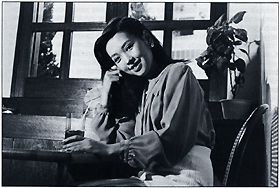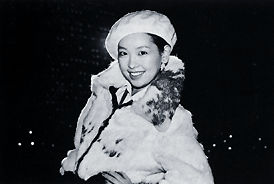CONTAX TLA Flash System Accessories
< Wide Panel Flash >
With the TLA30 you can take flash shots with a 35 mm wide-angle lens. Using the Wide Panel, which is supplied as standard accessory with the TLA30, you can extend the coverage to accommodate a 24 mm wide-angle lens.
 |
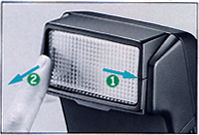 |
When the coverage angle is not wide enough for close-ups, you can eliminate flash light vignetting by tilting the flash head downward and converting to the Wide Panel. |
Mounting the Wide Panel
(1) Insert the tab on right side of the panel and press it against
spring on right side of flash head. (2)Then, press the entire
panel to lock into place.
Removing the Wide Panel (1) While pressing in direction of arrow against the tab on left side of the panel, (2) pull the panel toward you.
Effective flash range in TTL and Normal Auto modes, and guide numbers on the Manual mode are affected when using the Wide Panel because of an increase in angle of coverage. Use the Exposure Computer Dial as directed below to ascertain the correct exposure,
In the TTL and Normal Auto Modes Rotate and set the Exposure Computer Dial by aligning the Wide Panel index mark "
In the Manual Flash Mode Rotate the Exposure Computer Dial, setting the ASA film speed in use to the Wide Panel index mark corresponding to the same flash output value used in setting the Flash Mode Selector. Then read out the correct coverage aperture for the applicable flash-to subject distance and set the aperture accordingly.
< Using the TLA Extension Cord 100S >
When employing the TLA Extension
Cord 100S, which is sold separately, the flash unit can be used off camera at different
positions and angles, permitting a variety of special off-camera flash techniques
not possible with at-camera flash.
Attaching the Extension Cord Insert the clip-on unit into the camera's accessory
shoe and then plug the other end of the cord into the Extension Cord Socket of the
TLA30 and secure by tightening the locking ring. The flash unit can now be charged
and flashed in the off-camera position. And by combining the TLA Multi Connector
S, TLA Extension Cord 10OSS and 30OSS, all of which are sold separately, you can
increase the movable working radius of the flash unit for enhanced application. However,
the combined length of the extension cords should not exceed 10 meters. *
When shooting in the Normal Auto flash mode, be sure to maintain flash unit's sensor
on your main subject.
With the flash unit used off-camera, you can obtain the following effects.
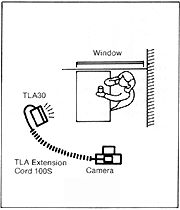 |
1) For portraits, a pleasing "three-dimensional" effect may be produced by holding the flash unit diagonally off to the side at an angle pointing down on the subject. By projecting the flash in this way, you will be able to give variation to the subject's expression and shadow areas. |
|
2) Vignetting and uneven lighting
which often occur with close-ups may be eliminated by using the optimum angle and
position of the flash for the particular shot. 3) For bounce flash, ft is possible
to position the flash unit while taking the lighting effects into account.
< Using the optional TLA
Multiple Flash System
>
With the TLA30, you will be
able to take multiple flash shots in the TTL Auto mode by using, TLA Multiple Flash
System Accessories (TL-A Multi Connector S, TLA Extension Cords, TLA Extension Connector
S, TLA Attachment Adapter),
When using a Contax with direct TTL auto flash metering system, the light from the
multiple flash units are metered and controlled for correct exposure by the camera's
sensor system after the light has passed through the lens. Multiple flash can be
effectively used in the following situations.
a) In cases where a single
flash would produce dominant shadows, multiple flash can be used to provide supplementary
lighting to fill in or relieve the shadow area. 2) When a flash unit is placed directly
to one side of subject to produce a three dimensional effect, a supplementary flash
can be employed to help lighten the shadow area that would otherwise be too dominant,
thus enabling you to attain a balanced lighting effect. c) For portraits in a room
with expansive background depth, where the flash unit is incapable of reaching the
background, a single or multiple flash directed at the background will help lighten
it.
While there are various other flash techniques available, in any instance, it will
be necessary to take into account the best possible position for effectively illuminating
your subject.
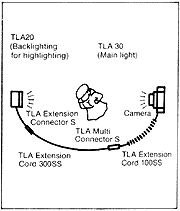 |
While the position and angle of flash units for multiple flash are influenced by the prevailing picture-taking situation or your photographic intent, factors basically essential to good lighting effects are based on considerations for lighting balance in which you have made clear distinctions between the functions of main and secondary sources of flash illumination. |
|
The technique generally applied
is one of using balanced lighting by varying the flash-to-subject distance of each
flash unit. Techniques available for using flash as supplementary lighting are bounce
flash, diffused flash, reduced output flash in the manual mode, etc.
* When taking multiple flash
in the Auto flash modes, avoid using extension cords with a combined length exceeding
10 meters. Always be sure to check that the Flash-Ready Lamps of all units are lit.
** When more than three flash
units are hooked up for multiple flash, excessive flash exposure may occur.
*** Normal Auto flash mode is
not suitable for multiple flash because of difficulty involved in determining the
correct light factor.
TLA Flash System
Accessories
TLA Extension Cord 100 This extension cord, measuring 1 meter
overall, is used in taking off camera flash with the TLA20 and TLA30. The shoe unit
for accepting the flash unit base is provided with a tripod socket underneath.
 |
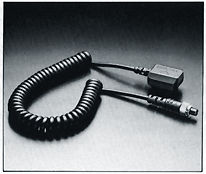 |
TLA Extension Cord 100S The TLA Extension Cord 100S, designed for use with the TLA20 and TLA30, is used in taking off-camera flash shots and in connecting to the TLA Multi Connector S for multiple flash shots. |
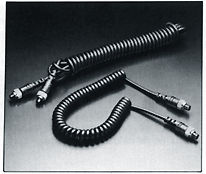 |
TLA Extension Cords 100SS and 300SS The 100SS and 300SS are used in making multiple flash shots by connecting to the TLA30, RTF 540 TLA Adapter, TLA Multi Connector S, and Extension Connector S. The 100SS is a spiral cord type, measuring 1 meter long-, the 300SS, a straight cord type, measuring 3 meters long. |
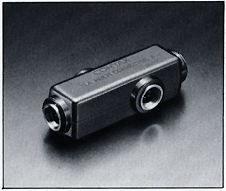 |
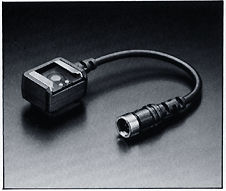 |
TLA Multi Connector S This unit is specially designed for use with TLA20 and TLA30 in taking multiple flash shots, handling a maximum of three flash units. Depending upon the prevailing picture-taking situation or your photographic intent, you can connect it to Extension Cord 100S, 100SS and 300SS for various multiple flash applications. |
TLA Extension Connector S The TLA Extension Connector S, being a connector for linking the TLA20 with Extension Cord 100SS or 300SS, is mainly used for multiple flash applications. The shoe unit which accepts the flash unit base is provided with a tripod socket underneath.
TLA Attachment Adapter This adapter is used when securing the TLA30 to a tripod when making multiple flash shots.
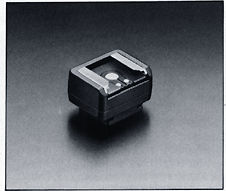 |
You can considered Download a Copy of the PDF file (1.9MB) of the entire system chart for CONTAX flash group for your future reference (avoid if you can unless you are looking for certain specific information critically - it will kill my line if having multiple simultaneous downloads ....) |
Technical Specifications:
Type: Clip-on auto
flash unit with direct TTL control; normal auto flash featuring built-in sensor on
flash unit.
Guide numbers (ASA/ISO 100, meters): On AUTO - GN 30 to 4 (continuously variable);
on MANUAL - GN 30 at full output; and GN 15 and 7.5 at reduced output.
Control Circuitry: Energy-saving series circuitry with automatic flash cut-off.
Mounting: To camera hot shoe directly, or by Extension Cord for off-camera.
Flash Modes: TTL Auto, Normal Auto (with two aperture ranges), and Manual
(with three-way guide numbers).
Flash Control: TTL Auto flash - SPD flash metering system housed in camera
measures flash directly at the film plane and cuts off flash output for correct exposure
(Only on Contax camera with direct TTL auto flash metering system); couples at all
apertures with lens 'in use. Normal Auto - SPD sensor housed in flash unit automatically
cuts off flash output, coupled at two aperture ranges (f/4.0 and f/8.0 at ASA/ISO
100, m).
Angle of Coverage: 60° horizontal; 45°
vertical (coverage for a 35 mm wide-angle lens). Wide Panel: 76°
horizontal; 58° vertical (coverage for a 24 mm wide-angle
lens).
Color Temperature: Equivalent to daylight.
Power Source: Four 1.5 V AA size penlight batteries (rechargeable Ni-Cd type
of same size also usable).
Recycling Times: Using alkaline-manganese batteries approx. 9 seconds (at
full output).
Number of Flashes: Using alkaline-manganese batteries - approx. 100 (at full
output).
Flash Range-Check: TTL Auto mode - indicated by LED mark "![]() " inside camera viewfinder;
Normal Auto mode - indicated by Auto Check lamp on flash unit.
" inside camera viewfinder;
Normal Auto mode - indicated by Auto Check lamp on flash unit.
Bounce Angle: Up to 90° vertical (with click stops at 60°
75°, and 90°),
down to 15° vertical.
Effective ASA Coupling Range: ASA/ISO 25 - 880 Flash Test: By pressing Test
Button which doubles as Flash-Ready Lamp.
Other Features: Provided with Power Switch and Extension Cord Socket.
Accessories: Accessory Wide Panel, case and test sheet supplied as standard accessories.
Size: 80 (W) x 120 (H) x 60 (D) mm. Weight: 290 grams without batteries.
* Recycling Times
refer to the time required for subsequent lighting of Flash-Ready Lamp, firing the
unit using fresh batteries. ** Number of Flashes refer to the number of times the
Ready Flash Lamp will light within 30 seconds of previous flash when flash unit is
fired successively at 30 second intervals. *** The above specifications and design
are subject to change without notice.
NOTE: Content in this site is based largely on an Instruction Manual published in 1983 and thus some references on CONTAX SLRs and accessories used may NOT be applicable now. The Contact Information stated below were extracts from the old manual and MAY NOT be applicable now. It was intended ONLY to replicate in its original form.
YASHICA CO., LTD.,
Tokyo Office 20-3, Denenchofu-Minaml, Ohta-ku, Tokyo 145, Japan Tel: (03) 7%2240
YASHICA INC., USA Main Office 411 Bette Drive, Paramus, Now dersey 07652, U.S.A.
Tel: (201) 282-7300
YASHICA INC., MWMmetem Regional Office 120 King Street, Elk Grove Village, Illinois
60007, U.S.A. Tel: (312) 6404=
YASHICA INC., Westdrn Regional Office 344 Mira Loma Avenue. Glendale, California
912D4, U.S.A. Tel: (213) 247-2140
YASHICA INC., Dallas Service Station Empire Center. Suite No. 124,8383 Stemmons Freeway.
Dallas, Texas 75247,.U.S.A. Tel: (214) 630-2345
YASHICA CANADA INC. 7470 Bath Road. Mississauga, Ontario, L4T I L2, Canada Tel: (416)
671-4300
YASHICA 00 BRASIL LTDA. Rua Cruz a Souza 59. Aclimacao. Sao Paulo, Brazil Tel: 288-2389
e 289-8174
YASHICA EUROPE G.m.b.H. BillstraBe 28, 2000 Hamburg 28, West Germany Tel: (040) 78-15-21
YASHICA HANDELSOESELLSCHAFT m.b.H. Rustenschacherallse 38, 1020 Wien, Austria Tel:
(0222) 72-34-72
VASHICA AG, ZOrcherstraSe 73, SSW Thalwil. Switzerland Tel: 011720 34 34
YASHICA AIS Industrivinget 2, DK-2880 Glostrup, Denmark Tel: 2-830806
YASHICA SVENSKA AB., Box 715, KostervAgen 3, S-181 07. LidingO Sweden Tel:. 08-767-9045
YASHICA HONGKONG CO., LTD. Room 1101, New World OfficeBuilding, 20 Salisbury Road,
Kowloon, Hong Kong Tel: 34MM1619
| Previous | 4/4 BACK to Main Index Page of CONTAX FLASH SECTION.
Other Contax Accessories: Filters | eyecups / Diopter lens / Right Angle Finder / Magnifier| Lens Caps/Lens Rear Caps / Body Caps / Lens Pouches | Soft lens Shades/Metal Lens Hoods/Adapter Ring/Gelatin Filter Holder set | Focusing Screens
| Back | to Index Page of Contax
RTS
| Back | to Index Page of Contax
RTS II Quartz
| Back | to Index Page of Contax
RTS III
| Back | to Main Index Page of
Contax RTS series models
Camera
Models: | Contax RTS |
RTS
II
| RTS III |
Shared
Resources:|
Motor
Drive-
PMD
W6| Winder - RTW-W3 | Screens |
Flash | Macro | Remote | Databack | Accessories | Zeiss T* Optic | Instruction Manuals: Contax RTS HTML | PDF | Contax RTS II Quartz
HTML | PDF | Contax RTS III (3
parts PDF
by mike@butkus.org, M. Butkus, NJ. Part A | Part B | Part C |
OFF TOPIC:- Personal Note
| Message Board | for your favorite Contax RTS Series SLR Models
| Message Board | for your Contax optics
in a shared environment
| Message Board | Specifically for Dispose or Looking for Contax Photographic
Equipment
| Main Reference
Map: RTS - HTML | PDF (206k) RTS II - HTML | PDF(308k) RTS III - HTML | PDF |
Specification: RTS - HTML | PDF(159k) RTS II - HTML | PDF(66k) RTS III - HTML | PDF |
1975: RTS 1979: 139Q 1980: 137MD 1982: 137MA 1982: RTS II |
1985: 159MM 1987: 167MT 1990: RTS III 1992: S2 1992: S2b |
1992: ST 1994: RX 1996: AX 1998: Aria 2000~ |
| List of Carl Zeiss T* lenses for Contax SLR cameras | ||||
About this
photographic
site.
| Home - Photography in Malaysia |
Credit: Mr. Timothy Daley of www.alkit.com <cameras@AS400.alkit.com> for both of his images on TLA20 and TLA30; MClau, joint maintainer of the Contax RTS MB. Some of the content are extracts from: Cees De Groot, who maintains a Contax FAQ site and Tim Roger website on Contax SLR cameras, A few of the images on Zeiss lenses were downloaded from Contax US website. My buddy, Yeak † & Rizal Yahya, for their cool programming with Contax RTS's Message Board, Note:certain contents and images appeared in this site were either scanned from official marketing leaflets, brochures, sales manuals or publications published by Kyocera over the years and/or contributions from surfers who claimed originality of their own work solely for educational purposes. The creator of the site will not be responsible for any discrepancies that may arise from such possible disputes except rectifying them after verification."Kyocera", "Yashica", "Contax" & "Carl Zeiss T*" are registered trade names of Kyocera Corporation Inc., Japan. A site made with an Apple IMac, dedicated to all fans of Contax cameras and Zeiss Optics.
